MXA INTERVIEW: ERIC PERONNARD WANTS TO CHANGE THE WORLD—AND HE HAS
 Eric Peronnard (right) and Stark Future’s owner, Anton Wass.
Eric Peronnard (right) and Stark Future’s owner, Anton Wass.
BY JOSH MOSIMAN
HOW DID YOU GET STARTED IN PROMOTING EVENTS? I have always been in the event business. I was organizing bike launches, adventure rides and a lot of stuff before its time. I have been one of the pillars of the Paris Supercross since 1988. They asked me to work for them, and I became their U.S. representative. That opened the floodgates for me. Next, I was hired by Geneva Supercross, then by Saporiti FastCross in Italy, which was a very big race in the 1980s and 1990s. Around then I was involved in more and more races. We went to Milan and Barcelona. I honestly forgot how many races I worked. It was very exciting, but at the same time it’s a bit sad because none of those races are still alive.
HOW DID THE LAS VEGAS U.S. OPEN COME ABOUT? My wife and I were talking, and she said, “Why don’t we do a race ourselves?” I’m like, “Sure, let’s do something at the highest level if we can.” That was the beginning of the U.S. Open project in 1996. That led to meeting the Fox and MGM Grand people. Two years later, we launched the U.S. Open, which was a landmark in motorcycle racing. It’s been 25 years now, and we still have the record of how much we paid for one race. The purse for the race in 1998 was $300,000, and no riders raced at the MGM Grand without being fully compensated. It was a race that didn’t charge money to any rider or team. It was very successful, which was good because we were generating enough money to pay everybody and still make a profit.
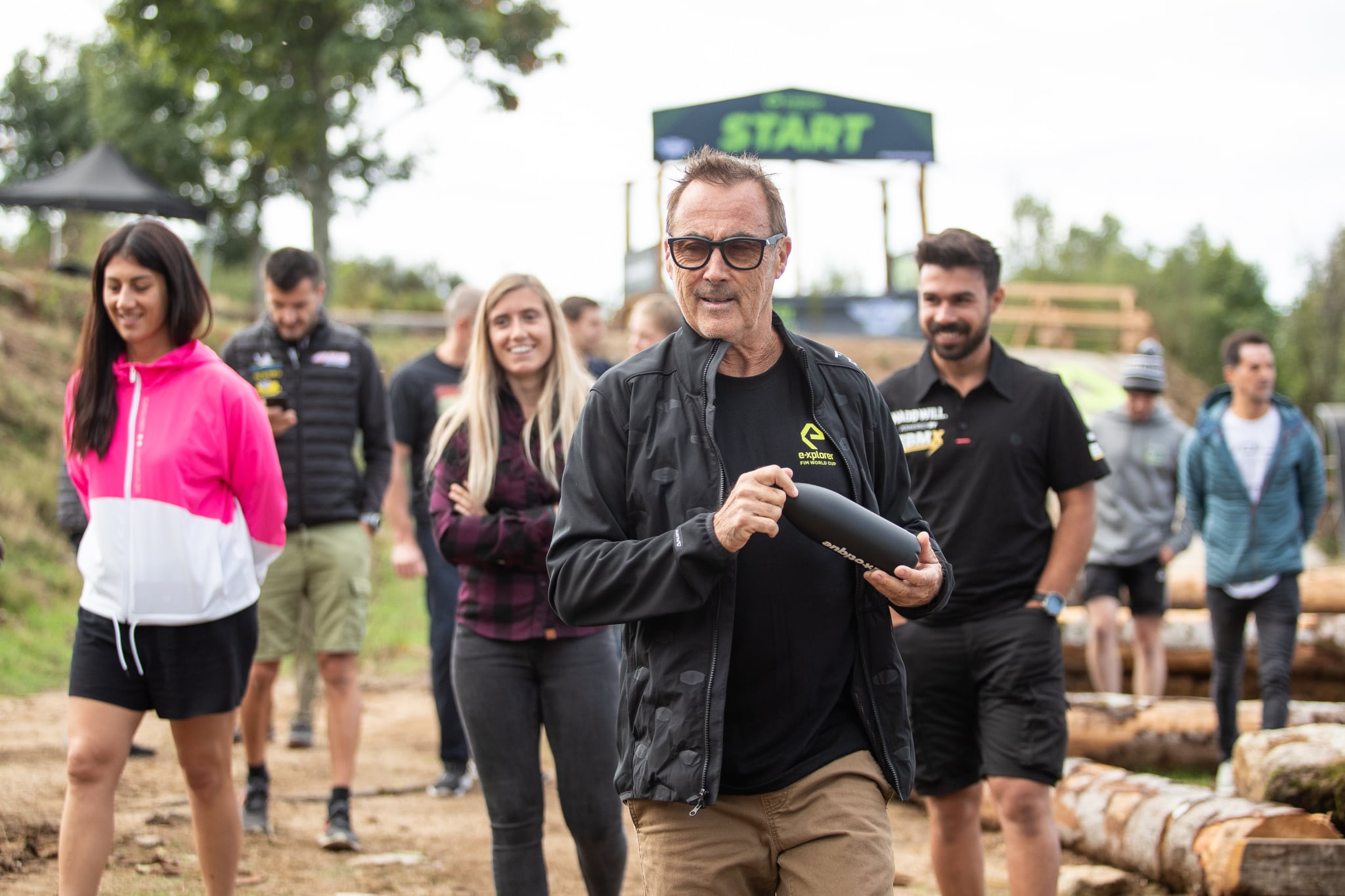 Eric Peronnard at the pre-season race for the new E-Xplorer electric bike series.
Eric Peronnard at the pre-season race for the new E-Xplorer electric bike series.
THE U.S. OPEN WASN’T ALWAYS SUNSHINE AND RAINBOWS THOUGH, RIGHT? We ended up in court with the Supercross promoter. The AMA was not happy (and not good to us). They sold us the wrong title with the sanctioning fees. It was a mess. We kept doing the U.S. Open, very successfully. By year three, Gary Becker of Pace Management made us a purchase offer and we accepted. That was a big turnaround in my life because they also hired me to be the Vice President of what is known today as Feld Motorsports. I started working there to internationalize Monster Trucks and Supercross. We did the first World Supercross Series 20 years ago. I kept going with them until 2004; however, I couldn’t get enough traction on getting new stuff going, so I resigned.
“I HAVE BEEN ONE OF THE PILLARS OF THE PARIS SUPERCROSS SINCE 1988. THEY ASKED ME TO WORK FOR THEM, AND I BECAME THEIR U.S. REPRESENTATIVE. THAT OPENED THE FLOODGATES FOR ME.”
WHAT CAME AFTER YOUR STINT WORKING AT SUPERCROSS? When I resigned, I had in mind the EnduroCross project and the Mini Moto project. I launched those things, which turned out to be quite successful. Three years later, I sold them both to a publishing company called Prime Media. Mini Moto lasted another six or seven years until the pit bike fad died, and EnduroCross is still alive 18 years later.
HOW DID YOU FINANCE ALL OF THIS? My wife and I had a big Yamaha dealership in Las Vegas in the 1990s that we sold to bankroll the U.S. Open. The timing was perfect. We had an offer to sell, and we needed cash because the U.S. Open was a multi-million-dollar project. It was really helpful to have the cash from the dealership to make it happen. The MGM Grand was willing to trust the vision we had, but they were not willing to pay for it. So, they basically said, “Hey, all the money is going to be under our wing, and if there is any left over, we will give it back to you,” which was the case.
Then we moved to Florida, where we are now, and after three or four years of doing everything, we built a new KTM, Polaris, Indian and Victory dealership in New Smyrna. It was a good business venture, and we sold it a couple of years ago.
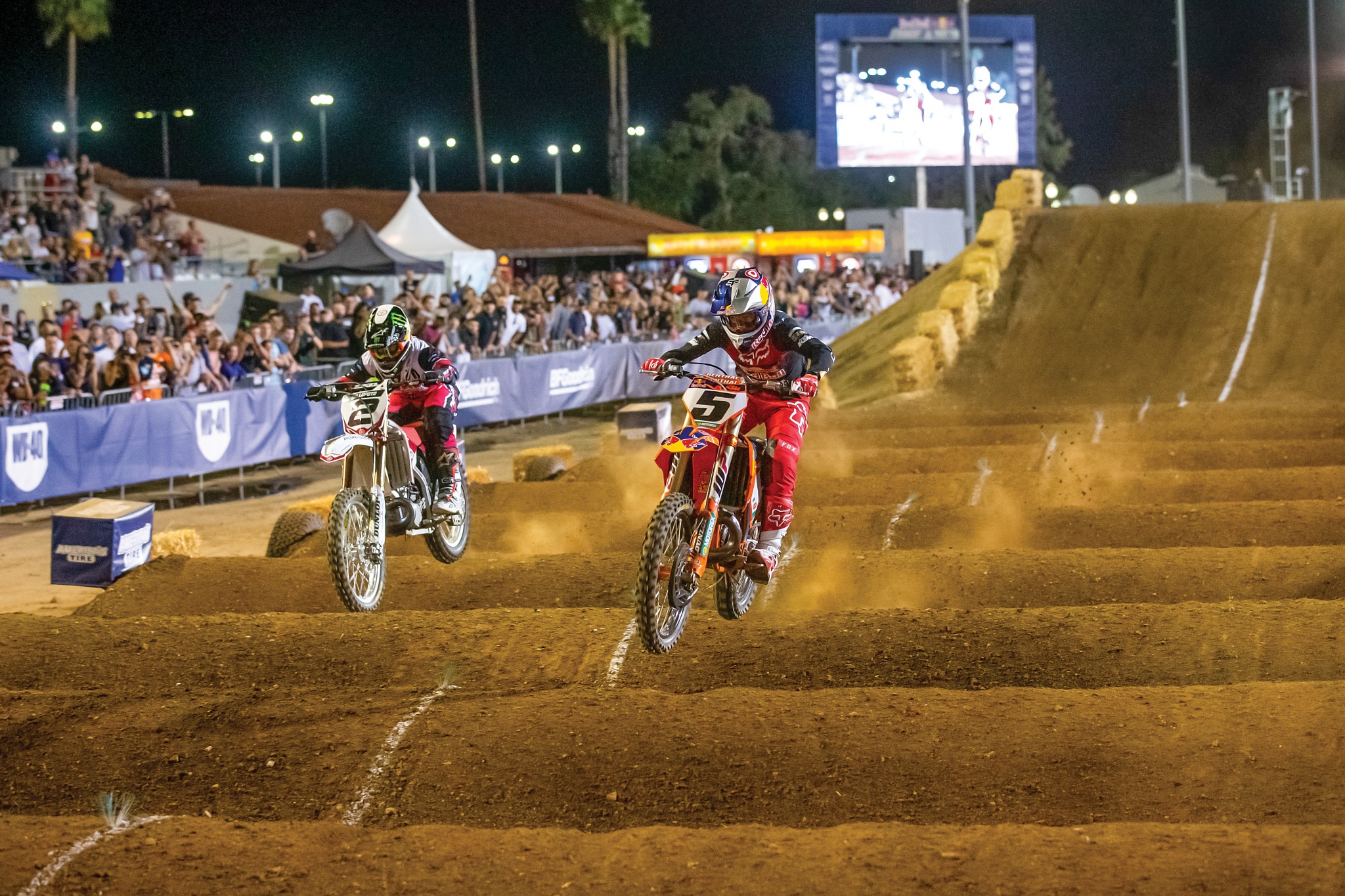 The Red Bull Straight Rhythm is a popular event that was created by Eric and Red Bull.
The Red Bull Straight Rhythm is a popular event that was created by Eric and Red Bull.
DO YOU EVER TAKE TIME OFF? I promised my family that I would take a break, so in 2009 I took my wife and two boys around the world for 12 months of riding motorcycles and visiting friends. When I came back, within a week ESPN was calling me to be at X Games. I had a week to unpack, and I was gone to Los Angeles for X Games.
From 2010 to 2019 was amazing. We had more business and more work. We had a lot of successes but not always. Some projects didn’t go well, but that’s the name of the game. It’s like a singer who has bad songs. We got involved with Red Bull and launched Straight Rhythm. We did the Tennessee Knockout, which now is a World Championship Extreme Enduro. I’m still working with Monster, doing a lot of Monster shows, like Freestyle, Best Whip and all that stuff. I also continue with all of the international races. I had the chance to be involved in the launch of the Hawaiian Supercross, which died of COVID, and the Montreal Supercross as well. Now, it’s getting back to being busy again. It seems like the last months have been like pre-COVID times.
HOW DID YOU GET YOUR START WORKING IN THE MOTOCROSS INDUSTRY? Very simple; the only two things I knew in my life were that I would be in America and I would be in the motorcycle business. I was 15 years old, and my room was covered with JT Racing posters, Scott USA posters and anything American. After that, it was just a matter of pursuing my dreams. I came to the U.S. in 1979 for the first time, then went back to France. Every time I came to the U.S., I was growing as an adult. When I came back to France after my first trip, a friend of mine who was in his 30s said, “Hey, I want to buy a motorcycle dealership. I don’t know much about moto, but you know everything about it, so you’ll be my partner. Let’s do it.” We opened a Suzuki dealership in 1980, and it was a cranking dealership in France within four years.
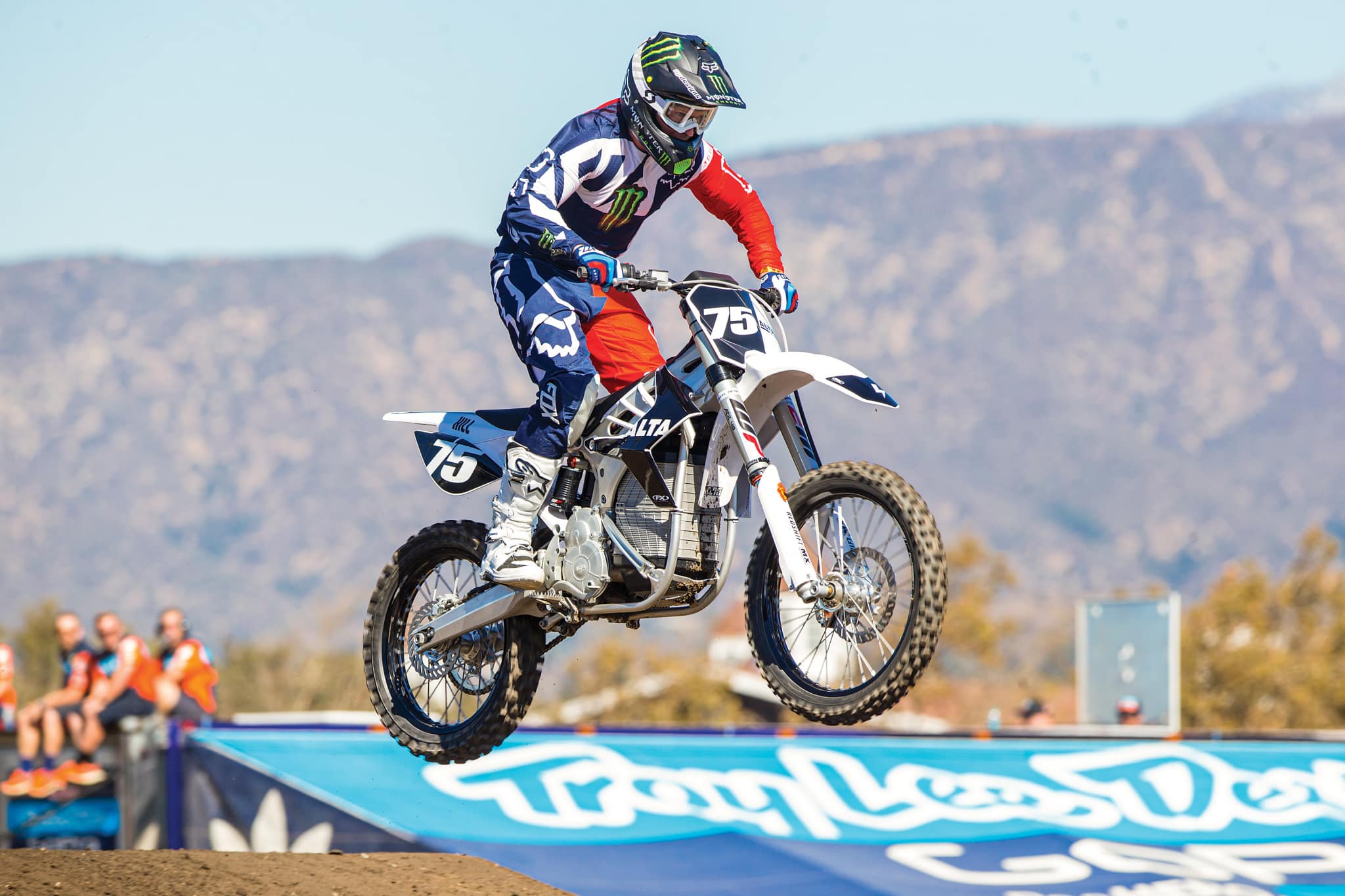 Josh Hill on the Alta electric bike at Straight Rhythm.
Josh Hill on the Alta electric bike at Straight Rhythm.
HOW DID YOU GET YOUR START IN THE U.S.? Around the time of the Suzuki dealership, I had a small business as a distributor for Scott USA and other companies that I was trying to sell in France, but the economic climate was really bad. I got burned. I lost a lot of money, and that was what drove me to move to the USA. It was 1985, and I said, “Okay, now it’s time.” I took the Dodge van that I had in France, because I wanted to be an American, and I drove it to the Cologne Motorcycle show. I met with all the American companies there, including Jim O’Neal. Lots of people said, “Come to America; we’ll have a job for you!” Jim O’Neal was the only guy who kept his word.
“I ALSO STARTED AS A JOURNALIST AT THAT TIME. I WANTED SO MUCH TO BE IN A COMPETITIVE FIELD THAT I OFFERED MY SERVICES TO MOTOVERT, A FRENCH MAGAZINE. IT’S THE MOTOCROSS ACTION OF FRANCE, BASICALLY THE SAME AGE, TOO.”
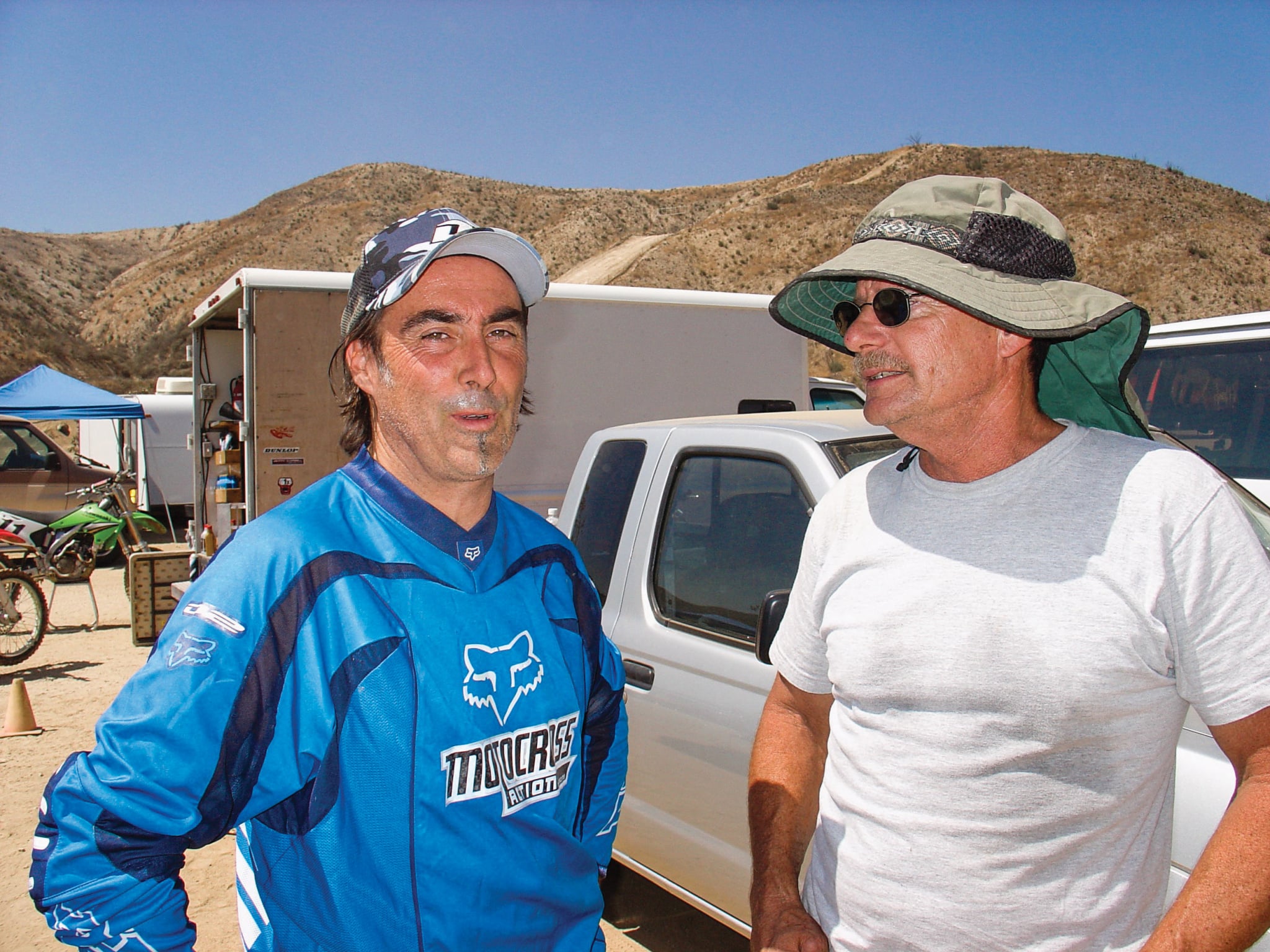 Eric Peronnard (seen here with famous mechanic Eric Crippa) is the founder of the U.S. Open Supercross. He is also a motocross racer himself when he has time in his busy schedule.
Eric Peronnard (seen here with famous mechanic Eric Crippa) is the founder of the U.S. Open Supercross. He is also a motocross racer himself when he has time in his busy schedule.
WHAT WAS YOUR JOB AT O’NEAL? I was the sports marketing guy, even though that title didn’t exist. I was taking care of sponsored riders and, at that point, most of Jim’s sponsorship money was invested in Andre Malherbe, the then World Motocross Champion. Andre was a friend of mine, so it was very easy to deal with him. Plus, O’Neal had Erik Kehoe, who is still a good friend to this day. That was the mid-’80s.
I also started as a journalist at that time. I wanted so much to be in a competitive field that I offered my services to MotoVert, a French magazine. It’s the Motocross Action of France, basically the same age, too. It’s one of those iconic magazines. I was their U.S. representative, and that was fun.
YOU’RE VERY BUSINESS-MINDED. WHAT WERE YOUR PARENTS LIKE? We were a very sporty family. My dad was a professional hockey player, but that was at a time when you didn’t make any money. My mom was always working, for department stores and stuff like that. I didn’t have any business inspiration, I just had a never-giving-up attitude, like my dad. He was running marathons at 60 years old. He never gave up until he got cancer, and that was the end of his life, sadly. I was very fortunate to be in a great family where I had access to a lot of fun stuff, but we never had excess, you know?
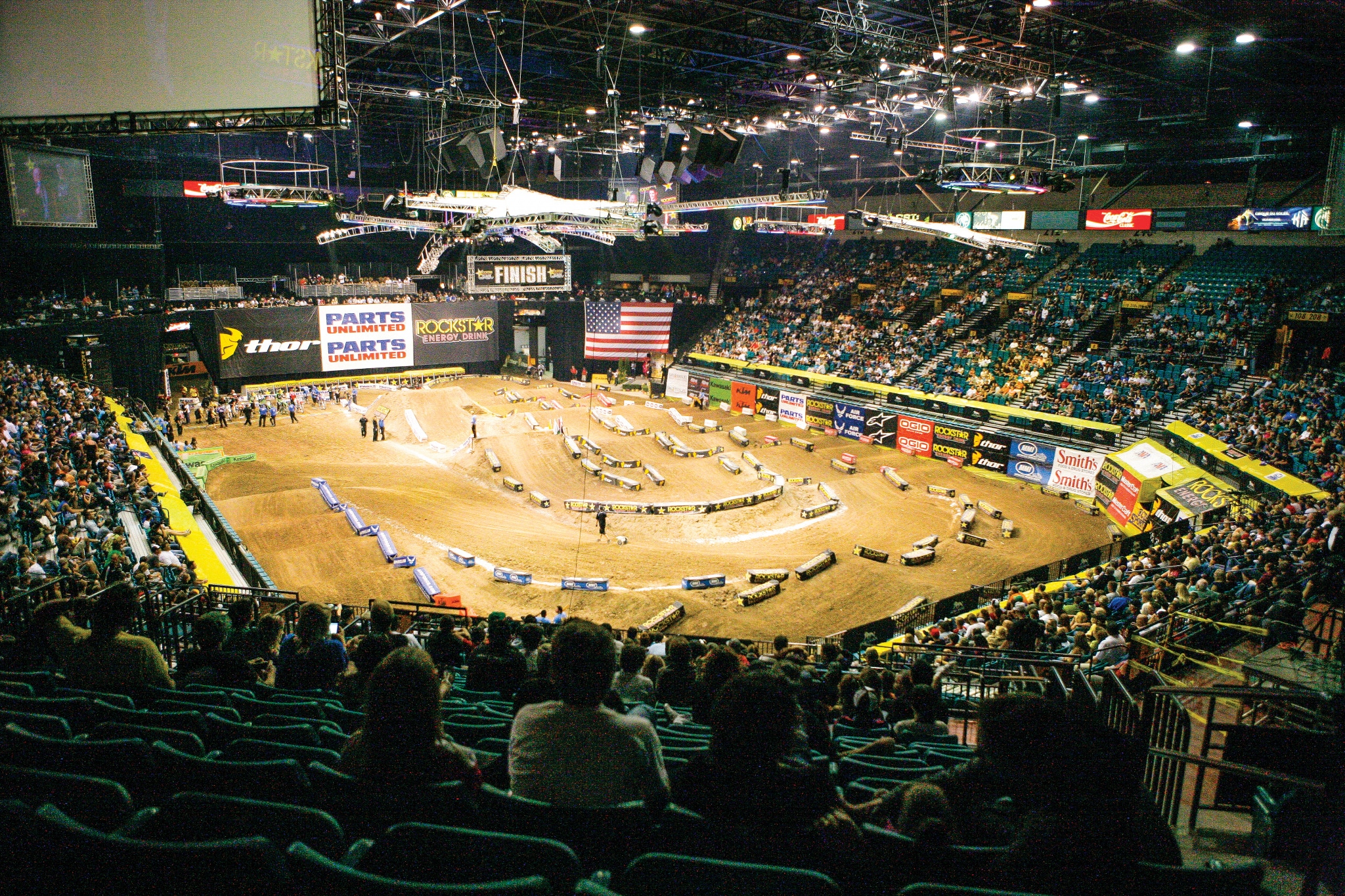 Eric Peronnard, although French, was fascinated by America and became one of the most influential men in American motocross and Supercross.
Eric Peronnard, although French, was fascinated by America and became one of the most influential men in American motocross and Supercross.
WHEN DID YOU GET YOUR FIRST MOTORCYCLE? I grew up in France, and I got my first bike at 16 years old. It really could have been better if I would have been racing at 10, but at 16 I started racing, and I was the guy who wanted to do everything. I wanted to race motocross one weekend, Enduro the next weekend and trials the next. Being bored very quickly makes you do a lot of different things, for better or worse.
YOU WERE INVOLVED IN SUPERCROSS WHEN IT BECAME AN FIM CHAMPIONSHIP, RIGHT? Absolutely. I was swimming in that situation. When I became a Vice President of Pace Management, it was at the time of the JAM Sports disaster. The AMA had given the rights of Supercross to JAM Sports. The group I worked with at Pace included Todd Jendro and Dave Prater, who are still in the motorcycle industry today. There was a misunderstanding about the AMA’s position. Roy Jansen and I were the two global guys. We had a vision outside of America. Between Roy and I, we explained to Pace’s owners that since the AMA was reporting to the FIM, that if Pace made a deal with the FIM to sanction a World Supercross Championship, suddenly the AMA would be irrelevant and couldn’t tell us what to do.
NOT EVERYBODY KNOWS ABOUT THE AMA VERSUS SUPERCROSS PROMOTER CIVIL WAR. CAN YOU LAY IT OUT FOR US? Pace was one of the three companies that owned Supercross. It was Mike Goodwin, Pace and Bill West. The three companies evolved into one group owning the entire Supercross series. Right at that point, the AMA gave the rights to Supercross to somebody else, which was JAM Sports. It got pretty ugly, and it put Supercross in danger. JAM Sports had purchased or had an option to purchase Supercross from the AMA for an enormous amount of money, way more than what Pace was paying.
The tipping point came when Pace signed with the FIM to run the World Supercross Championship. Suddenly, the AMA had no choice because the FIM told the AMA, “Hey, we’re doing the World Championship. We’re not doing a National Championship.” The idea was to have Supercross races outside of the USA. We had races in Canada a couple of times. We had a race in Switzerland, a race in Holland and a couple races in Spain, but that idea cooled down quickly because the big teams were not very supportive about traveling worldwide.
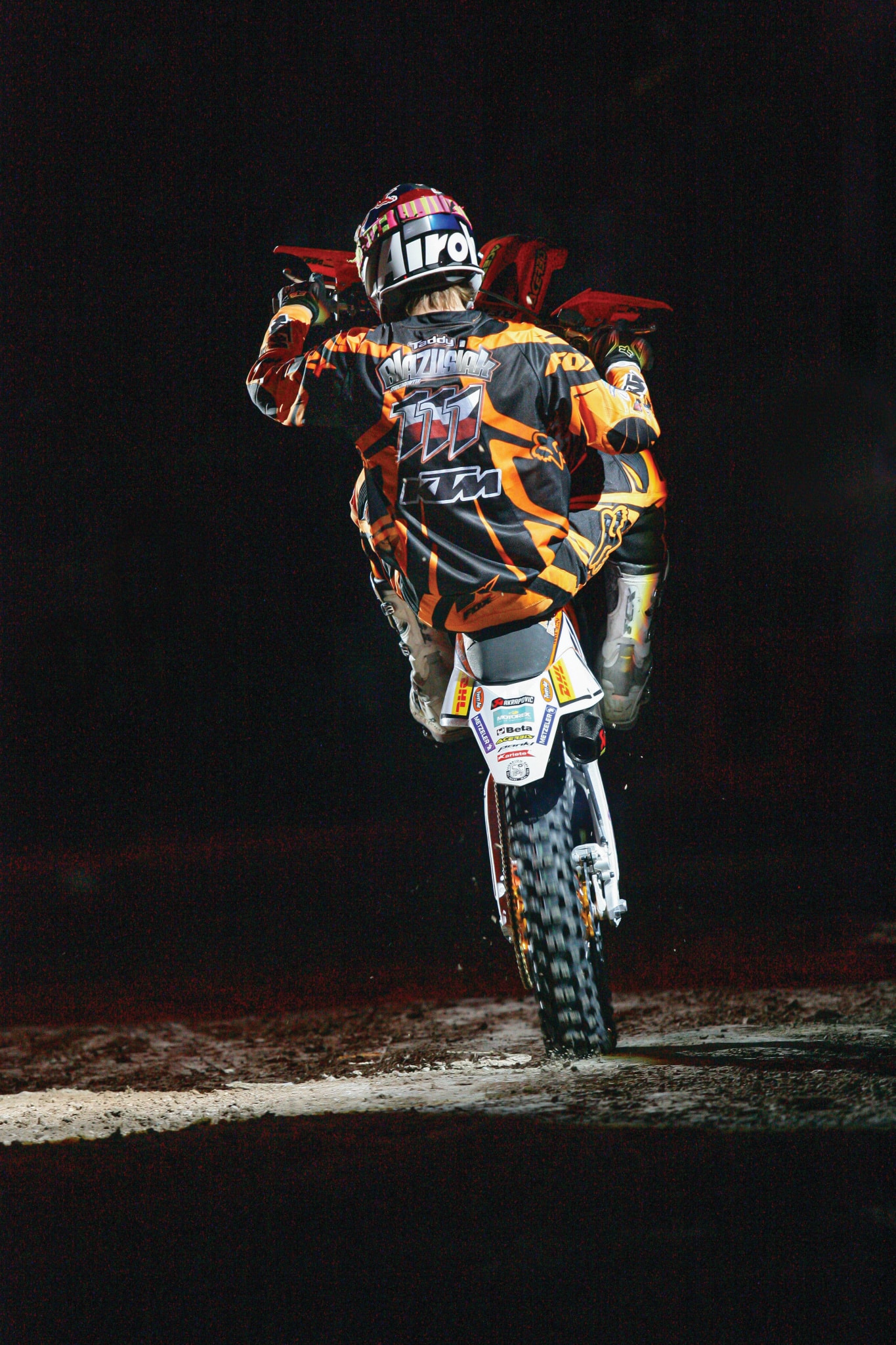 Eric’s EnduroCross created all-new racing opportunities for off-road racers like Taddy Blazusiak.
Eric’s EnduroCross created all-new racing opportunities for off-road racers like Taddy Blazusiak.
CAN YOU EXPLAIN YOUR INVOLVEMENT IN ELECTRIC MOTOCROSS BIKES? Fifteen years ago, when I was doing Mini Moto, I met the founder of Zero Motorcycles, Neal Saiki. That guy was a rocket scientist, literally from NASA, and was totally into electric bikes. I tried his bikes and I found them quite interesting. At the time, no one was talking about electric cars and there were no electric mountain bikes; it was just a cool spin-off.
An electric powerband is kind of magic to a point. I rode it and said, “Hey, let’s do a race.” We got Jeremy McGrath, Jeff Emig, Sebastien Tortelli and plenty of good guys to race. We lined them up on Zeros and Quantyas, and we had an electric motorcycle race at the Orleans Arena in Las Vegas at the Mini Moto event. We played classical music in the background and nobody got it. I stayed involved with Zero for a couple years until Zero got acquired by another group and they decided to go full street. So, that was the end of that.
Very quickly Alta showed up and I met those guys. They knew my passion and involvement, and I was able to bring a few things into the picture. They asked me to join them, and I was an advisor to Alta for many years until the end.
“I DON’T THINK JOINING ELECTRIC AND INTERNAL COMBUSTION ENGINES WILL CHANGE THE RESULTS, BECAUSE WE’RE NOT REINVENTING THE BIKE. ELECTRIC OR GASOLINE, THE BIKE IS STILL PRETTY MUCH BASED ON AN EXISTING KTM, HONDA OR KAWASAKI.
 Eric doesn’t only promote races; he loves riding, too. He rode 24 times in one month this year.
Eric doesn’t only promote races; he loves riding, too. He rode 24 times in one month this year.
WAS THERE PUSHBACK FROM THE INDUSTRY WHEN YOU HELD THE ELECTRIC RACE AT MINI MOTO? Oh yes, there was a total lack of excitement. People were not ready for it. It was five years before Tesla. We were just having fun and had no idea where it was going. Nobody was talking about electric bikes replacing internal combustion engine bikes then. I’m not talking about electric bikes replacing them now either; some people are, but not me.
Alta came, and they were pretty receptive to some of my ideas. I would say the pinnacle of Alta was when we got Josh Hill to race the Straight Rhythm on it. I talked to Red Bull, and we brainstormed together. Josh said he would race the bike if we made the whoops a little bit smaller.
To me, the best thing we ever did was when I took Josh Hill to the Geneva Supercross in 2017. That was a year when we had Ricky Carmichael and Josh race each other. Carmichael on his factory RM-Z450 and Josh on the Alta. Having the “GOAT” race against an electric bike was, no pun intended, an electric moment. Everybody was standing up and I’m like, “Wow, this is cool!”
The following year, we took Ty Tremaine to Erzberg. His result was hindered because he took a wrong turn, but he could climb stuff that nobody else could climb, and that is what actually got him going in the wrong direction. So, that was sad, but that was racing. Then, within six months later, Ty got on the podium at the Reno EnduroCross in 2018. That was the biggest accomplishment in real racing for an electric bike, because it was between Cody Webb, Colton Haaker and Ty. There was no question it was his best result, and it came on an Alta. Then Alta shut down, which was a very sad moment.
HOW DID YOU GET INVOLVED WITH THE STARK ELECTRIC BIKES? After Alta folded, it was two years of crickets on electric bikes. Then, in early 2020, I’m driving to my track in Florida to go ride and I get a call from a Swedish guy telling me, “Hey, I’m working on a competitive electric bike. Do you want to get involved?” and I said, “Yes, I do. I don’t have much time, but I do.” Then COVID changed the time issue. Stark was born, and I was one of the first ones to ride the bike. It was phenomenal.
IS IT TRUE THAT YOU WERE TRYING TO GET JOSH HILL TO RACE THE STARK IN THE 2022 SUPERCROSS SERIES? The owner of Stark believes in inclusion. He wants to have a Stark at Supercross as soon as possible. I was hoping to do that for the 2022 Supercross season, but unfortunately, it’s not possible right now. I do believe in having electric and internal combustion engines racing together, but that’s not gonna be easy. There are a lot of political aspects to motorcycle racing, and it’s not looking very promising in the near future.
TELL US ABOUT THE E-XPLORER SERIES? I was approached by the group that’s starting the FIM E-Xplorer series. They come from Formula E. They know what it takes to bring electric racing to the masses. The CEO of the E-Xplorer series is actually a friend of mine. I know his dad. He’s a good off-road rider, and he called me and said, “I’m leaving Formula E, and I want to start my own motorcycle series. Do you want to be part of it?” I said, “Sure, I’ll help you.” It’s been a very surprising project, because the energy around it has been quite amazing. James Stewart is going to be a team owner, and he is so excited about the entire concept.
“EVERYBODY SAYS TO ME, ‘OH, YOU WANT THE FOUR-STROKE AND TWO-STROKE TO DIE.’ I SAY, “NO, I JUST WANT PEOPLE TO BE ABLE TO RIDE WHEREVER THEY WANT.'”
 During the pit bike craze, Eric held the Mini Moto events at The Orleans Arena in Las Vegas. Here’s McGrath (2), and Derek Costella (1) leading the way.
During the pit bike craze, Eric held the Mini Moto events at The Orleans Arena in Las Vegas. Here’s McGrath (2), and Derek Costella (1) leading the way.
IS THERE A SUCH THING AS TOO MUCH POWER? I’ve been lucky enough to ride some of the factory 450s, and I think the reality is that we don’t need that much power, except for the start. I don’t think joining electric and internal combustion engines will change the results, because we’re not reinventing the bike. Electric or gasoline, the bike is still pretty much based on an existing KTM, Honda or Kawasaki. It’s all the same frame geometry. It is the rider who will make the difference.
I think Stark is the Tesla moment of electric motocross. Tesla hasn’t taken over the world. They are selling 1,000,000 cars a year, but they’re not selling 40 million like Ford or Toyota. Ten percent of the world will be excited about that and 90 percent won’t. Sadly, our world is so polarized now. Everybody says to me, “Oh, you want the four-stroke and two-stroke to die.” I say, no, I just want people to be able to ride wherever they want. I think the noise issue is important, so maybe someday we can have a motocross track in the middle of Riverside, California, or New Smyrna Beach, Florida.
WHAT DOES MOTOCROSS MEAN TO YOU? It has given me the opportunity to meet wonderful people all over the world and discover unbelievable places. I’m very grateful to still be able to do it. At the end of the day, it’s not about talking about it, it’s about doing it. I’m excited about the possibilities for electric bikes because I hope it brings more people to the table. We’re never going to double the size of our sport, and that upsets me, but if we can maybe get another million people into motocross that’d be great.





Comments are closed.